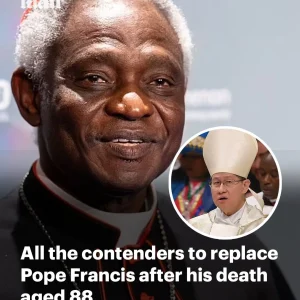The success of the blockbuster movie Conclave, which won both a Bafta and an Oscar in recent months, could not have come at a more opportune time.
For, following the death of Pope Francis, it offers us an insight into what will happen behind the scenes when the Catholic Church’s leading cardinals vote for his successor.
The election of a new pope is the most secretive democratic process in the world. The word ‘conclave’ – from the Latin ‘cum clave’, or ‘with key’ – vividly conveys its clandestine nature.
Yet when the latest conclave begins, at least 15 days after Francis’s death – which gives cardinals time to reach Rome from all over the world – those eligible to vote will not in fact be physically locked into the Sistine Chapel until they reach a decision.
Instead they will spend the night at a guest house within the Vatican’s walls known as St Martha’s House, where they will have the services of cooks and housekeepers plus two doctors.
Given the age profile of cardinals, even that level of medical provision might appear inadequate. Even though cardinals over 80 are not allowed to vote, the average age of electors during the last conclave in 2013 was, nevertheless, 77.
From St Martha’s House, they will walk daily in their blue cassocks and red sashes to the Papal Palace or the Sistine Chapel where the voting will happen.
There will be no interviews, TV debates or campaigning. Cardinals must also avoid newspapers, radio, television and the internet.
Cardinals at morning Mass in St. Peter’s Basilica, Vatican City, in 2005 before sequestering themselves in the Sistine Chapel for the beginning of the conclave to elect a new pope
The election of a new Pope is the most secretive democratic process in the world, conducted by 120 cardinals behind closed doors
Even if a holy man is tempted to break the rules, they will find it tricky. Last time, in 2013, technicians created a communications blackout. The Sistine Chapel will even be swept for bugs.
The conclave proper begins with a cry of ‘Extra omnes’ – or ‘Everybody out’ – an order for non-voters to make themselves scarce.
Those left may be there for some time. The longest conclave in history lasted 34 months, from the death of Clement IV in November 1268 until the election of Gregory X on 1 September 1271.
But in modern times, none has lasted longer than the five days – and 14 rounds of voting – it took to elect Pius XI in 1922.
It was the farcical 1268 conclave which led to the tradition of locking up cardinals until they decide.
Then, locals in Viterbo, 50 miles north of Rome, grew so irritated by the epic proceedings that they restricted cardinals to a diet of bread and water and even removed the roof of the church.
Once elected, Gregory X’s new rules said cardinals would have rations cut if they failed to decide within days. Modern conclaves tend to be far speedier.
The conclave to elect the late Pope Francis 12 years ago lasted just two days. To win, a candidate must attract a two-thirds majority.
Vatican announces Pope Francis has died in video statement
![]() If none achieves this, cardinals will engage in multiple rounds of voting until a final two remain. Then, a simple majority will decide the winner.
If none achieves this, cardinals will engage in multiple rounds of voting until a final two remain. Then, a simple majority will decide the winner.
The latest rules, drawn up in 1996 by Pope John Paul II, do not specify the conclave should announce it has decided by sending white smoke up the chimney outside the chapel. (Black smoke indicates no decision has been made.)
One thing the film underlines is the sheer breadth of candidates from around the world. While cardinals are not limited to choosing from their number – theoretically they can select any baptised male – it is almost certain that they will.
But that still leaves a selection of all shapes and sizes. And that creates a challenge given the new pope is expected to promptly appear on the balcony of St Peter’s in a pristine white gown.
Vatican officials will have sought to avoid embarrassment by laying out three gowns of different sizes.
The lucky candidate is unlikely to have youth on his side. Cardinals have a record of picking elderly popes.
There’s a famous saying that runs, ‘Young cardinals vote for old popes’, on the basis they don’t want anyone blocking their career path for years.
Upon the death of John Paul II in 2005, after 26 years, it is said cardinals deliberately turned to Joseph Ratzinger, 78, to avoid another long papacy.
Ralph Fiennes in the film Conclave, which with uncanny timing is up for an Oscar as the real thing takes place
It took just two days to elect Pope Francis, Argentine Cardinal Jorge Mario Bergoglio, in 2013
In the event, Pope Benedict XVI, as he became, retired after eight years. But that is nowhere near the shortest term.
Nine popes have survived less than a month after being chosen, with the most short-lived, Urban VII, lasting just 13 days.
And not every successful candidate wanted the job in the first place. In 1978, Cardinal Albino Luciani is reputed to have muttered ‘No, oh please, no’ when elected.
After reluctantly accepting, the 65-year-old took the title Pope John Paul, but 33 days later suffered a fatal heart attack.
This year, cardinals will hope that the man introduced to the faithful with the traditional cry of ‘Habemus papam!’ (‘We have a pope!’) avoids a similar fate.
But nor is he likely to break the record set by the very first post-holder in the first century AD. St Peter served for 34 years.






